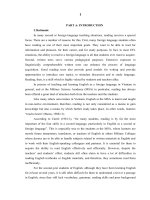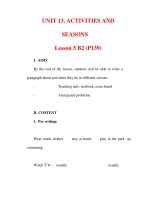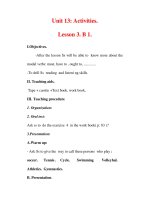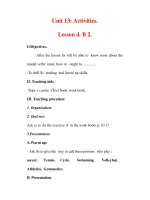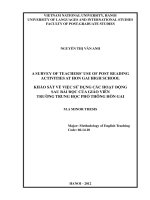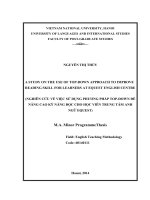Ten top reading activities handout
Bạn đang xem bản rút gọn của tài liệu. Xem và tải ngay bản đầy đủ của tài liệu tại đây (149.95 KB, 3 trang )
British Council Teacher Community
Top ten reading activities
This week we asked British Council Teacher Community members to suggest
their favourite reading activities. A selection of these can be found below, we
hope you find them useful. You can still contribute to the original discussion
(and tell us about your favourite reading activities) here. Thanks to everyone
who has contributed so far, we’re looking forward to reading some more of
your ideas very soon.
Chris and Marcus, April 2019
Pre-reading
Prediction | Fahima Seedat
Focus learners on the title (and anything else that’s known about the topic) and guess what may be
contained in the text – they then check their predictions by reading the text.
Prediction | Susan Main
As a prediction activity, I paste the text into then ask students to
guess the content of the text from the wordle.
KWL charts | Nasrin Anjuman Runi and Maryem Rchouk
before reading a text get learners to list everything they know about the topic – and then,
everything they want to know about it. This activates their schemata (topic-specific knowledge and
associated language) which aids reading comprehension. Having a list of things they want to know
about a text provides a learner-generated purpose for reading the text – it’s much more motivating
when reading to find the answer to their own questions, rather than other peoples’.
Return to the KWL chart at the end of the lesson and prompt learners to reflect upon and list the
things they have learned.
British Council Teacher Community | Ten reading activities
British Council Teacher Community
Top ten reading activities
While reading
Order a text
Photocopy and cut up a text (comic strips are especially good for this) before the lesson. Learners
then attempt to reorder the text. This can be done individually or collaboratively – doing this with
others can lead learners to engage with the text on a deeper level as they have to justify their
answers and reasons to peers.
Running dictation | Nancy
This is an energising reading (speaking, listening and writing) activity. Choose a short passage or
dialogue and make several copies. Put the copies up around the walls of the classroom (or even the
school building).
Put the students in pairs or small groups. The aim is for one of the students in each pair to walk (or
run!) to read the passage on the wall. They remember some of the passage and walk (or run!) back
to their partner. They quietly dictate what they remembered to their partner, who writes it down.
They then swap roles. Over several turns they will build the whole passage. This means they really
do have to run back and forth because students will only remember three or four words at a time.
The winning pair is the team that finishes first - although you need to check for mistakes. If there are
mistakes, they must keep walking to check!
A good idea is to teach them punctuation vocabulary beforehand if you want them to use the
correct punctuation in English. It's a good way to check spelling and fabulous for pronunciation - and
great memory training! (Taken from: />
Reading slaps
Help learners improve their scanning skills (quickly finding specific pieces of information) with
reading races. Put learners into groups according to reading level and provide them with large-print
copies of a text (one per group).
The teacher provides a piece of information referred to within the text, and learners race to be the
first to identify the relevant area of the text (by slapping it).
Follow up by eliciting the strategies that successful learners used (topic sentences, synonyms,
skimming beforehand) and then considering where this could be helpful in the real world.
Check and remake predictions
You don’t need to wait until the end of the text to check predictions. Prompt learners to evaluate
and if necessary, reconsider any predictions (made before reading) after reading a section of the
text. Breaking a larger text into smaller more manageable chunks, can help prevent some learners
getting left behind and lost in a larger text.
British Council Teacher Community | Ten reading activities
British Council Teacher Community
Top ten reading activities
After reading
Jigsaw reading
Give different texts to different learners. Following the reading stage, put learners into
groups consisting of individuals who have read different texts (and therefore have different
information about a given topic).
Learners then work within their groups to complete a task that requires them to combine
the information they got from their various texts. This can be a good way of differentiating
reading, as learners could be allocated texts (or questions) depending on their reading level.
Story recreation | Bayan Farah
Students retell a story, or present the information from a text in another medium (acting,
comic strip, poster.
Story extension | Zoe Tysoe
After reading a story, learners write the next chapter (or a prequal). This allows them to
demonstrate understanding of the original narrative and characters, provides an
opportunity to develop themes and personalise the story while enabling repeated
productive use of language from the text (which helps learners remember it).
British Council Teacher Community | Ten reading activities
